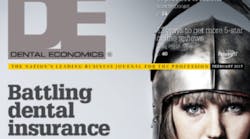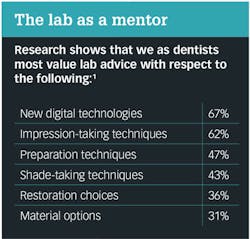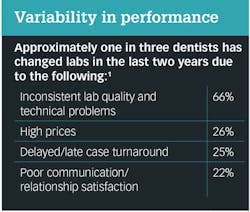How do I pick a great digital dentistry lab partner for my practice?
If you're like most dentists, you've changed labs because of inconsistencies, high prices, poor communication, and delayed cases. You can save yourself the headache by making sure that your relationship with a lab will be successful. It's a choice you should think carefully about, and here's what to consider.
To begin, we must ask: Why is this decision important? Digital restorative solutions, digital impression taking, networks, CAD/CAM systems, digital photography, and overnight shipping are inexorably changing our professional ecosystems and workflows. A great lab relationship is a core part of our ability to navigate the digital revolution and provide comprehensive care to our patients. For those starting out on the restorative digital journey, the lab can provide guidance, training, digital partnership, and even mobile in-office services when needed. For the intermediate and advanced digital dentist, the lab extends treatment and care capabilities, helping us and our teams stay on the forefront of workflow productivity and excellence.
In the emerging digital world, the lab is a vital part of our professionalism, patient response, profitability, and reputation. Our crown and bridge work—and our more complex cases—often account for approximately 40% or more of our workload. The right lab can elevate our care and treatment outcomes, as well as improve our efficiency and productivity by reducing/eliminating remakes and time-consuming traditional impression workflows. Finally, lab costs comprise 8%–10% of our overheads, a significant part of our economics. We need to get the best possible return on that expenditure.
Our ongoing relationship with our lab depends to a large degree on how the lab is able to sustain the initial quality level over time. It is not unusual to see a drop-off in quality after the first few restorations. There may be many reasons for this, so it is important to provide ongoing feedback to the lab. This can help them meet our expectations and allow for a long-term successful partnership.
For a detailed list of the three steps to finding and creating a great lab relationship, keep reading. You'll also find insights into why dentists change labs, and what advice we value most from our lab partners.
Step 1: Identify the qualities needed for a long-term practice-lab relationship.
• Personal communication and relationship potential that includes:
- Communicative and responsive staff ready to address questions, needs, and technical advisory requirements
- A lab team that is willing and able to sustain a long-term, partnership-style interpersonal relationship
- The ability to connect digitally via networks such as DDX
- Ethical behavior and trustworthiness
• The ability to provide a service that feels accessible or "local," even if the lab is situated a great distance from the office
• Punctuality and reliable turnaround times
• Outstanding accuracy, precision, and esthetics, as well as overall customer service that consistently and predictably meets expectations
• Fees that are fair and transparent, providing great value
• The ability to provide ongoing training, continuing education, and digital support for dentists and teams alike
• Advanced digital systems, workflows, equipment, and material science knowledge
Step 2: Identify your choices.
• We have found that reaching out to fellow dentists who have had experience with a lab is usually the most reliable way of finding a lab.
Step 3: Evaluate each lab and evaluate the trade-offs between the different labs.
• Review samples of each lab's work.
• Have a meaningful conversation with the lab owner, technicians, and customer support team, discussing your mission and values.
• Communicate your priorities and ascertain how well they fit with the owner of the lab.
• Let them know your expectations and preferred styles and channels of communication.
• Visit the lab and see it in person, with staff if possible.
- Would you feel comfortable sending a patient there for some customized work to be undertaken on your behalf?
- How engaged are the lab's team members?
• What materials are used in the fabrication processes? Are they ADA approved? Are they discussed with the doctor?
• Examine and discuss examples of different restorations, bite registrations, articulators, and occlusion. Are the digital restoration choices discussed with the doctor?
• Review the design and production equipment. Will the lab's range of services cover your needs? What are their plans to keep pace with advances in digital scanning, design, 3-D digital printing, milling units, and networks?
• How does the lab track and schedule cases?
- Are they able to accommodate any emergencies and rush jobs?
• How does the lab handle incoming impressions and preparations?
• How effective is the lab-to-doctor communication?
• How is the quality control managed in the lab?
• Is the lab well organized?
• Send a few cases as a trial and evaluate results.
Gary Kaye, DDS, FAGD, founder of the New York Center for Digital Dentistry, has practiced comprehensive dentistry in New York City since 1993. He graduated from Columbia University of Dental Medicine in 1993 where he received awards in endodontics, prosthodontics, and geriatric dentistry. Dr. Kaye consults with other dentists and dental manufacturers and lectures on topics including ceramics, occlusion, and digital dentistry. He is on the guest faculty of Planmeca University in Dallas, Texas.
Reference
1. Burns L. Why dentists are changing laboratories. Proofs website. http://www.dentistryiq.com/content/dam/diq/online-articles/documents/2013/03/06_1304labsurvey.pdf. Published April 2013. Accessed October 1, 2016.


